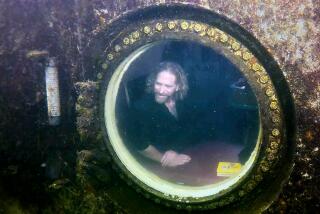UCSD Wins Grant to Study Sea Currents
- Share via
one day controlling the powerful flows of water, officials said Thursday.
The ability to better predict the mixing of currents could help environmental planners understand, for instance, the impact of sewage or chemical spills discharged into coastal waters.
At sea, wind or large ships can stir the water, generating underwater currents that are followed by huge wakes on the ocean’s surface that can stretch 10 miles.
Under the $4.7-million, five-year grant from the Office of Naval Research, scientists will examine how currents and wakes form.
“All of the mixing in the ocean occurs near the surface and this mixing only occurs through vortical action, like when we stir a cup of coffee,” said Morteza Gharib, a professor of fluid mechanics in UCSD’s Department of Applied Mechanics and Engineering. “The idea is to understand the physics of the ocean surface and how these vortices influence what happens at the surface on a large scale.”
To explore these questions, the team will construct a 30-foot-long water tunnel that simulates ship wakes.
The structure, 15-feet wide and 6-feet deep, will have a plexiglass surface called a splitter plate. This plate shears through the water surface, creating vortices--or whirling masses of water that form vacuums at their centers.
Researchers will measure each vortex created in the tunnel with a state-of-the-art mapping technique that uses reflective light rays. This technique enables scientists to see color-coded segments of the surface flow. They can also begin to gauge the dynamics and velocity of the vortex.
The research results will allow scientists to fine-tune existing models that analyze and predict currents and ship wakes, Gharib said.
“The Navy is really puzzled as to why ship wakes persist for so long,” said Gharib, the principal investigator for the project. “They wonder if all other actions and motions in the ocean also survive so long, and if so, why?
“We hope that at the conclusion of our experiments, we’ll be able to resolve this confusion.”
The team of UCSD scientists will include experts from other institutions, including: UCSD’s Scripps Institution of Oceanography, the Massachusetts Institute of Technology, the City College of New York and Science Applications International Corp.






